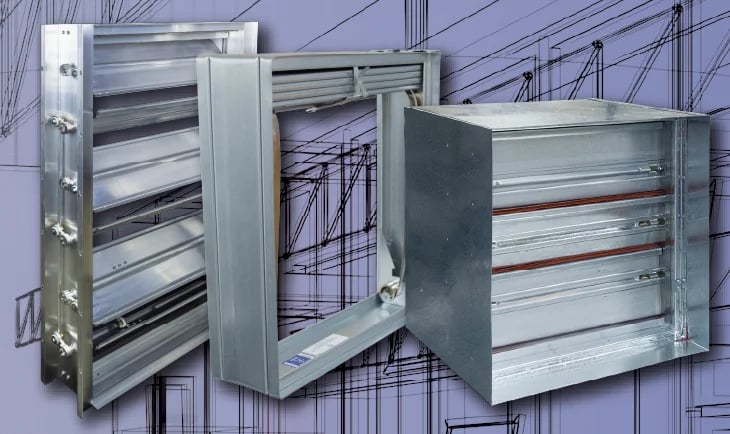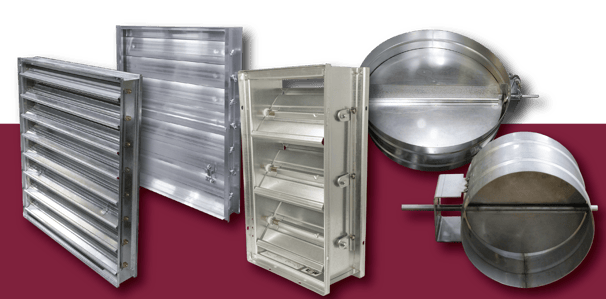So many dampers to choose from, but what do they do? Read more about the five types of dampers, now available on the MCDLG Newsstand.
HVAC systems can be large and complicated in buildings with many rooms, such as office buildings or schools. You will need more than duct work to get air to each of these areas. That’s where dampers come in. A damper is a device comprised of blades contained in a square or rectangular frame. This design can vary based on the type and model of the damper. For instance, some dampers can have a round frame to fit into circular ductwork.

Even though they are similar in design, there are several distinct types of dampers in HVAC, and each type of damper will perform a specific task. The following are five types of dampers commonly found in an HVAC system.
Looking for HVAC dampers? Consider adding control dampers from Arrow United Industries. We can help you navigate your specs and find the perfect dampers for your upcoming project.
.png?width=240&height=350&name=AFD20%20-%20Control%20Damper%20(Resize).png)
#1 Control Dampers
Control dampers are installed at various points in the duct work to regulate the flow of air through the system. These dampers can also be adjusted for use in air mixing zones for heating and cooling air. Control dampers will fully open or fully close their blades many times a day to perform their given task.
Control dampers are designed for air performance, with smooth blade profiles that minimize pressure drop when the damper is fully open.
You can choose to install a variety of different actuators to control the movement of the blades. For more on these accessories, read our Newsstand article on actuators.
#2 Balancing Dampers
.png?width=250&height=425&name=1660%20-%201661%20-%20Steel%20Balancing%20Damper%20(Resize).png)
Balancing dampers regulate air pressure in rooms connected to the duct work. Air pressure imbalances can cause minor annoyances for occupants, like slamming doors or random gusts of air, but they can cause larger problems for the entire system. An imbalanced room can be more difficult to heat or cool, putting excess strain on the air handling units.
Balancing dampers are adjusted by technicians, who will measure the air pressure in a room as they adjust the angle of the damper’s blades. Once the correct air pressure is found, the balancing damper’s blades are locked in place to maintain the necessary air pressure. They can be unlocked in the future for adjustments.
Learn the difference between control dampers and balance dampers with the MCDLG Newsstand.
#3 Backdraft Dampers
.png?width=300&height=412&name=366%20-%20Backdraft%20Dampers%20(Resize).png) Backdraft dampers restrict air flow to one direction only. These dampers have shafts installed on one end of each blade. This design turns the blade into a flap that only opens when air is flowing in the right direction.
Backdraft dampers restrict air flow to one direction only. These dampers have shafts installed on one end of each blade. This design turns the blade into a flap that only opens when air is flowing in the right direction.
Backdraft damper blades will close if no air is passing through or if air begins flowing in the opposite direction. Backdraft dampers can have a counterbalance installed to assist or resist the opening action. These dampers do not receive actuators. This action can relieve pressure in particular areas of the system, or act as a gate between portions of ductwork.
Read more about how backdraft dampers work in our Newsstand article.
#4 Multi-Zone Dampers
Multi-zone dampers are used in buildings with a single air handling unit, such as single-building schools or small-scale office buildings. These dampers are large assemblies comprised of multiple dampers, each tied to a specific zone. Multi-zone dampers connect to multiple ducts and control the flow of air for the entire system.
Multi-zone dampers will have multiple actuators, each controlling a specific zone. These dampers are often bundled with the air handling unit as a complete package..jpg?width=550&height=367&name=354%20-%20Multi-Zone%20Damper%20(Resize%2c%20HS).jpg)
.png?width=300&height=329&name=530-531%20Airfoil%20Industrial%20Damper%20(Resize).png)
#5 Industrial Dampers
Industrial dampers withstand massive air pressures and constant temperatures far above 250°F. These dampers are built from thick gauge materials, like rolled steel, to withstand extreme conditions. All attached components are welded in place to ensure maximum durability.
These dampers are typically used in factories and power plants; places that require serious air flow. Industrial dampers are the heaviest dampers around.
For more information on these dampers, read this article on the MCDLG Newsstand!
BONUS - UL Life Safety Dampers
.png?width=300&height=314&name=FS1%20-%20Combination%20Fire-Smoke%20Damper%20(Resize).png) UL Life Safety Dampers are specifically designed, tested, and rated for use in passive fire protection systems. These dampers have special accessories that close off the damper at the first signs of fire and smoke. This action prevents the passage of fire and smoke through duct work, giving occupants time to vacate the building during a fire event. The following are several types of UL Life Safety dampers:
UL Life Safety Dampers are specifically designed, tested, and rated for use in passive fire protection systems. These dampers have special accessories that close off the damper at the first signs of fire and smoke. This action prevents the passage of fire and smoke through duct work, giving occupants time to vacate the building during a fire event. The following are several types of UL Life Safety dampers:
- Fire Dampers for Static and Dynamic Airflow
- Smoke Dampers
- Combination Fire-Smoke Dampers
- Ceiling Radiation Dampers
Dampers for Many Applications
There are several types of dampers available, and each type serves a purpose. Your HVAC system may require all these dampers working together, except for the single multi-zone damper which is installed with a single air handling unit. Although you will use all these dampers, it’s important to know what each damper does and where it will fit into your HVAC system.

Check out more articles on control dampers, available now on the MCDLG Newsstand:
- Five Specialty Dampers for HVAC Design
- Damper Showdown - Control versus Backdraft
- Air Performance and Control Dampers
- The Big Three Metals for Louvers and Dampers
Which dampers do you use the most? What did you install or order for your last project? Share your stories in the Comments section. We want to hear from you!
MCDLG & Continuing Education
Want to know more about UL Life Safety dampers? MCDLG offers free self-paced courses online through AEC Daily.
Our UL Damper course, Fire & Smoke Protection with Life Safety Dampers, goes over all of the basic stats, terms, principles and requirements involved in choosing UL-rated dampers for your passive fire protection system.
This course provides continuing education credits for a variety of institutions, including ASHRAE's PDUs. Learn the basics of UL dampers and earn credit, at your own pace. Visit the MCDLG course page on AECDaily.com today!
Do you have a question on something we haven't covered here? Or maybe you need help from industry experts? MCDLG can help. Contact us by clicking on the button below.
.webp?width=91&height=70&name=MCDLG%20Logo%20(Resize).webp)
.webp)





